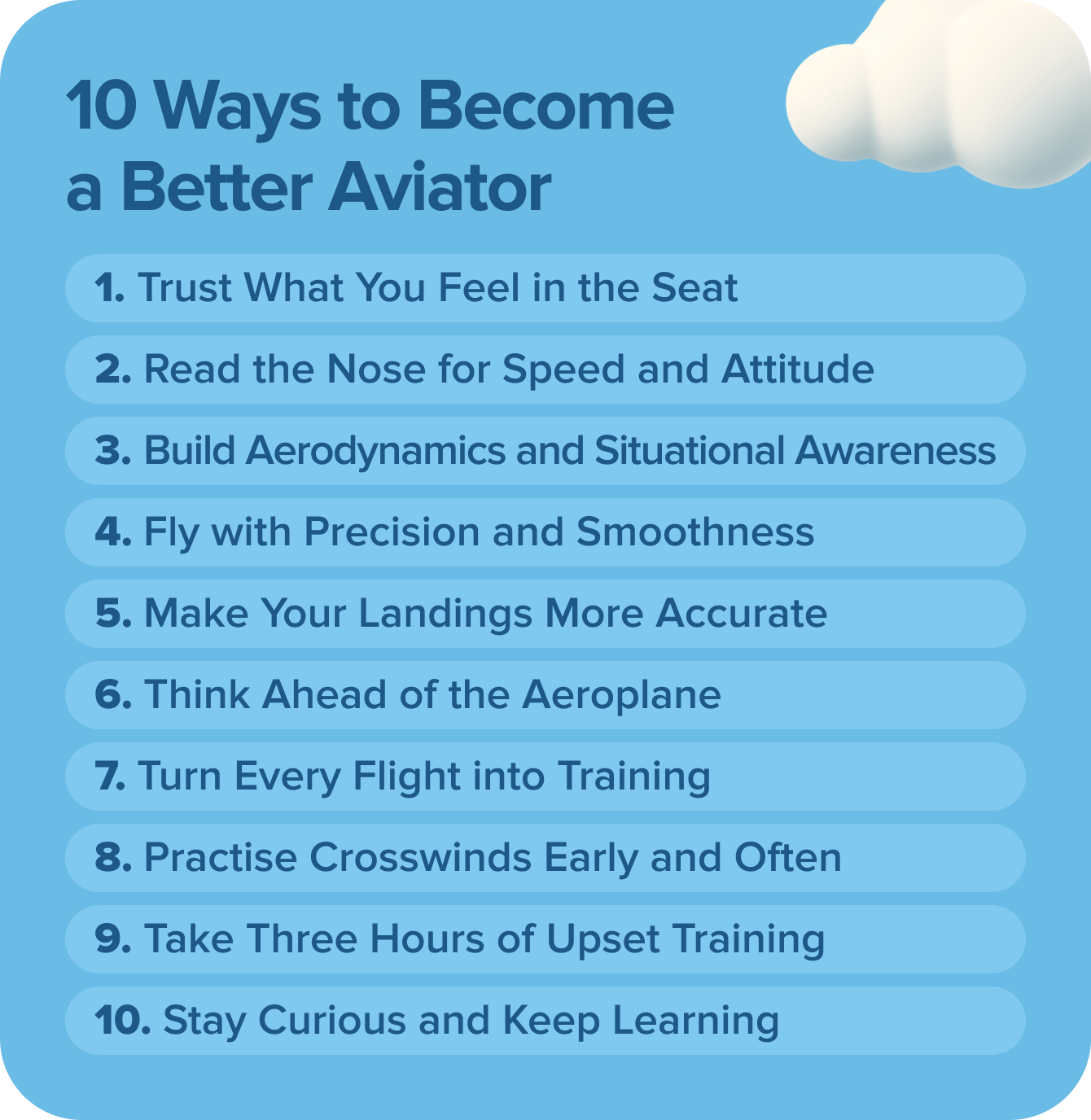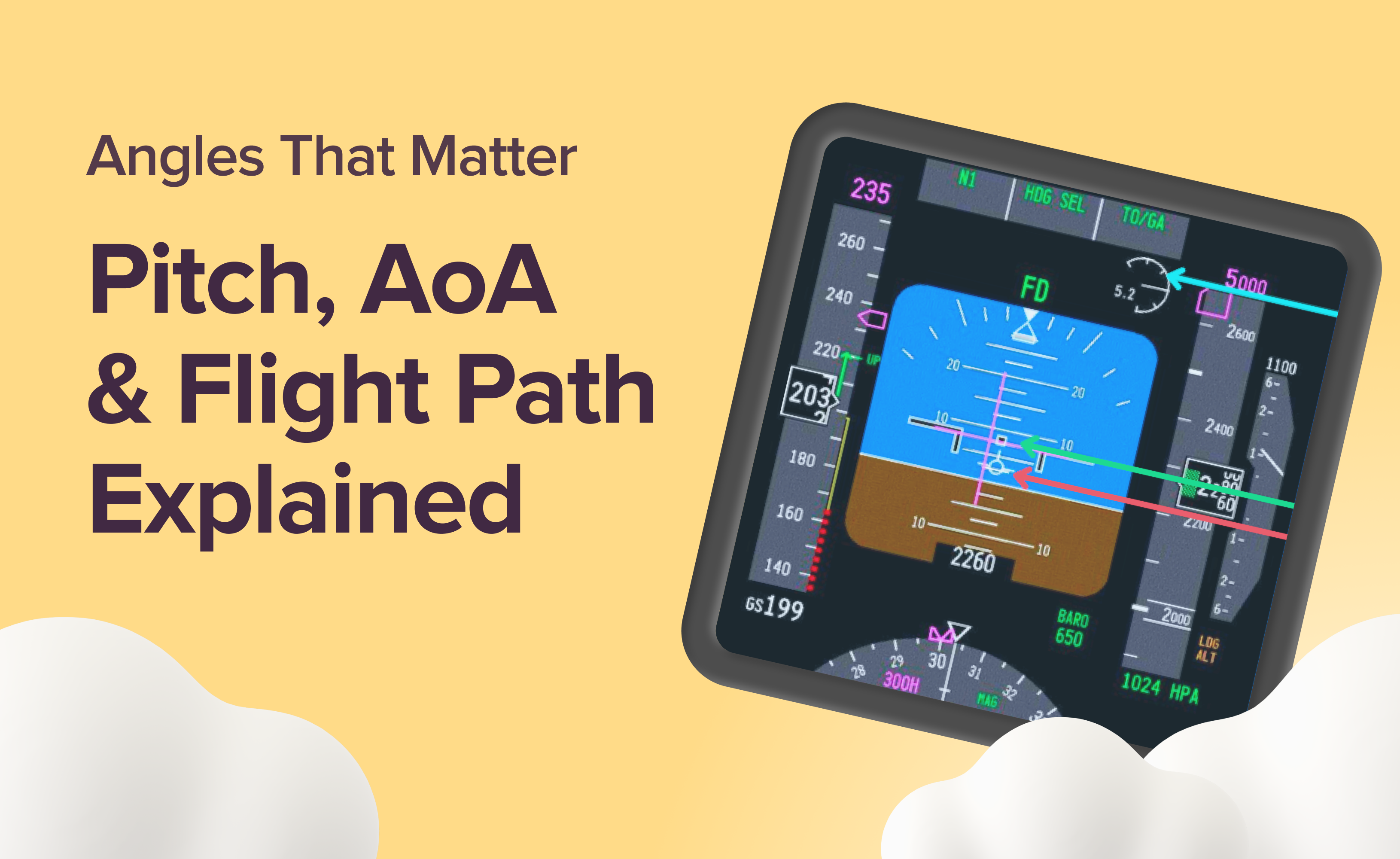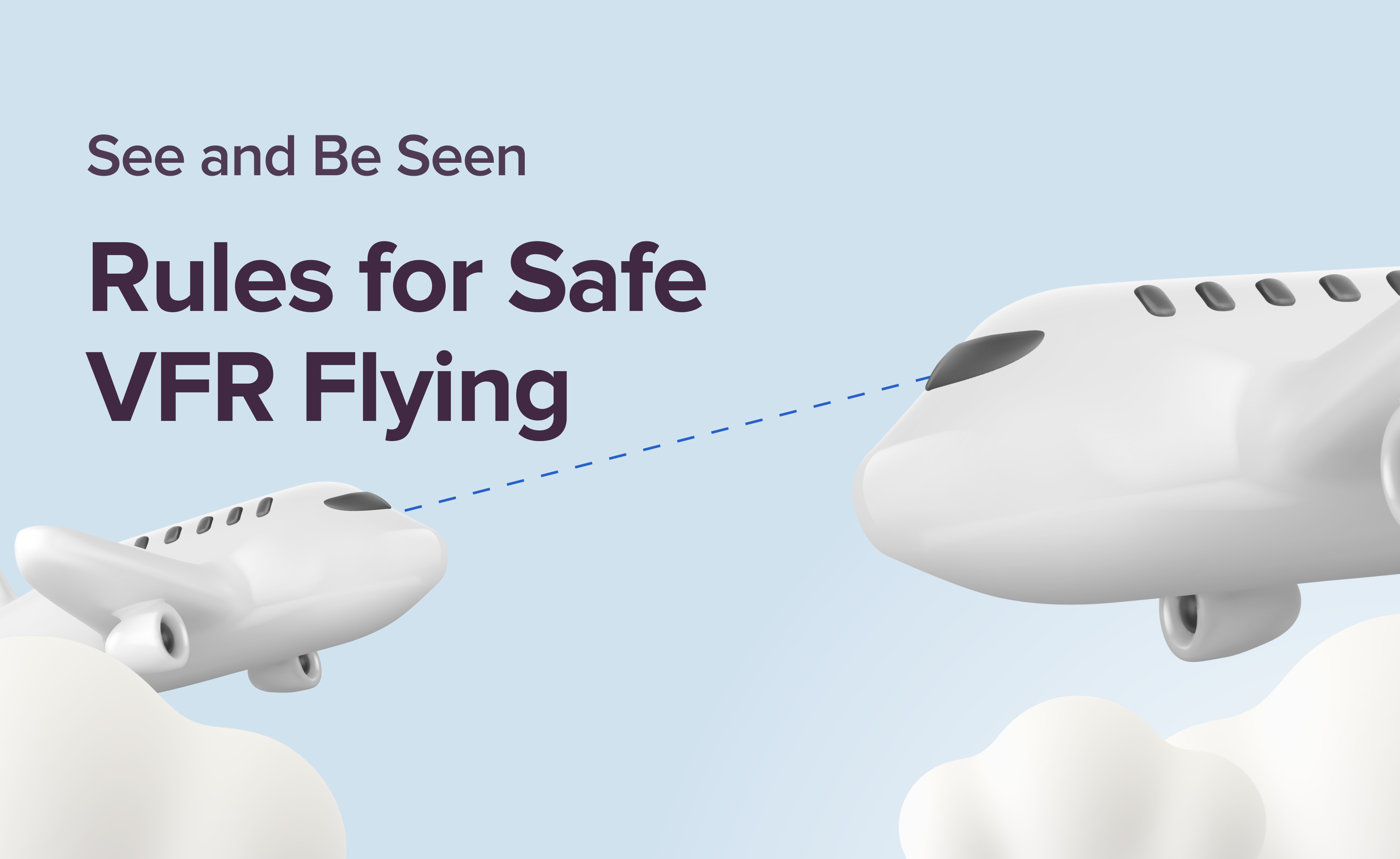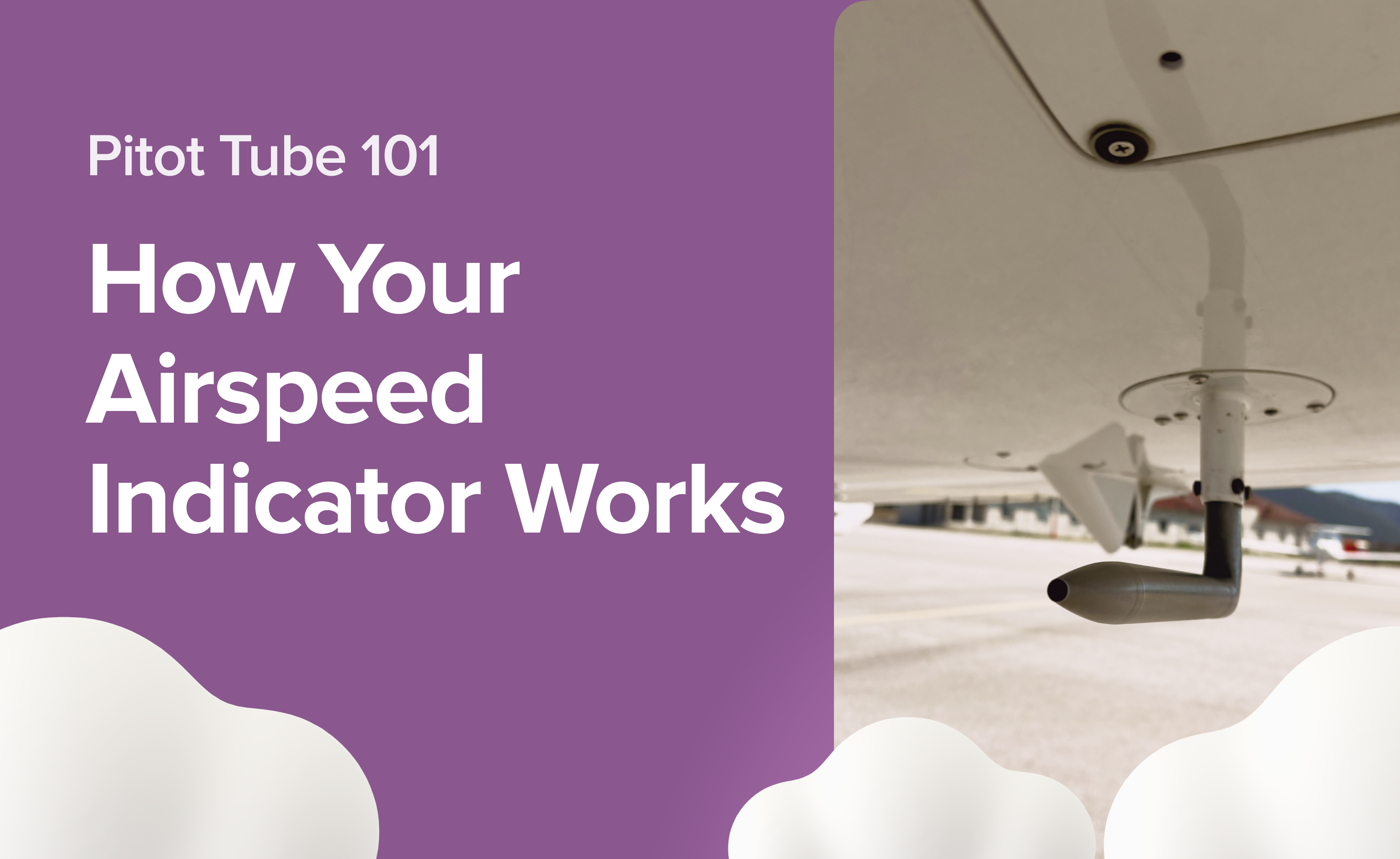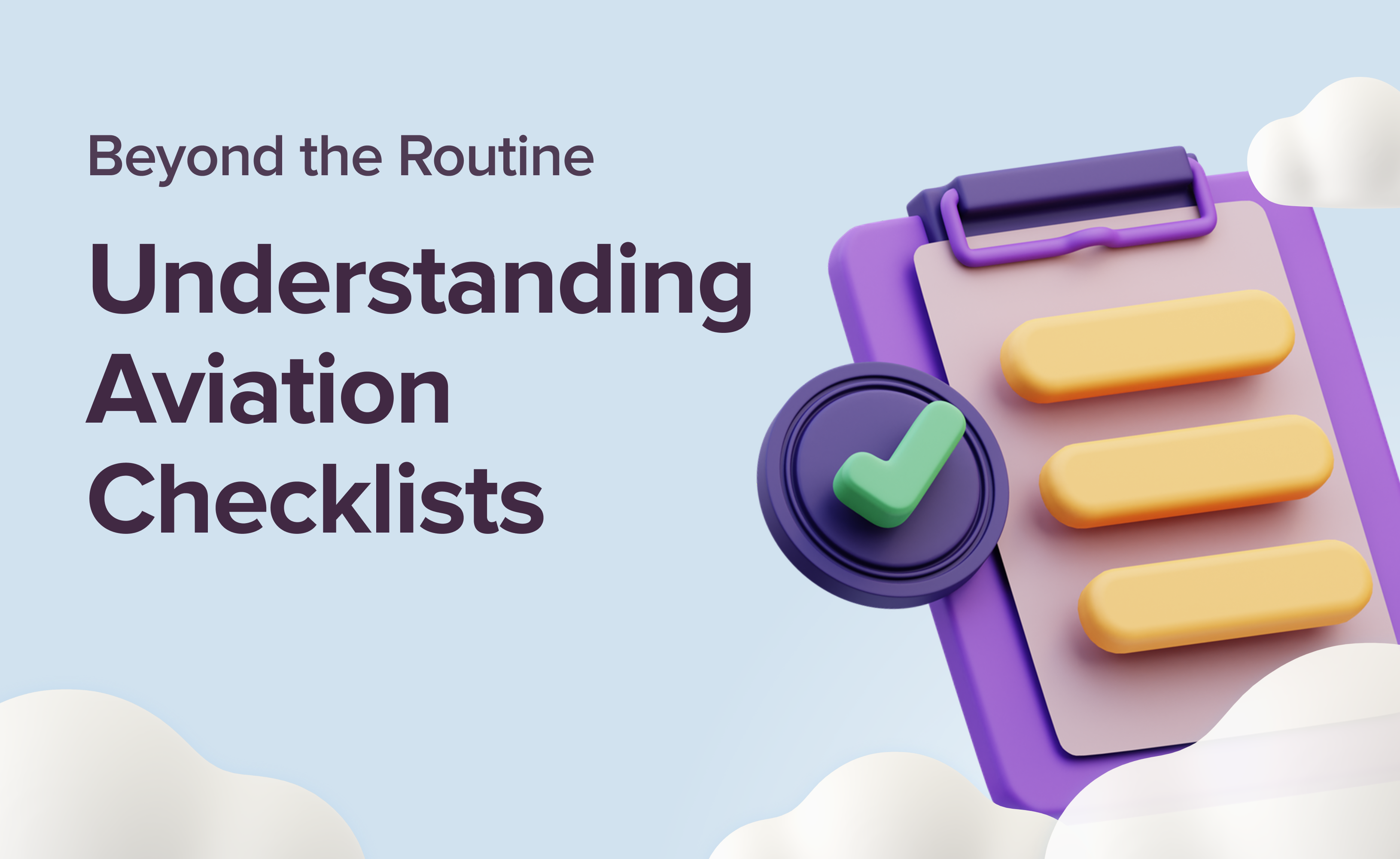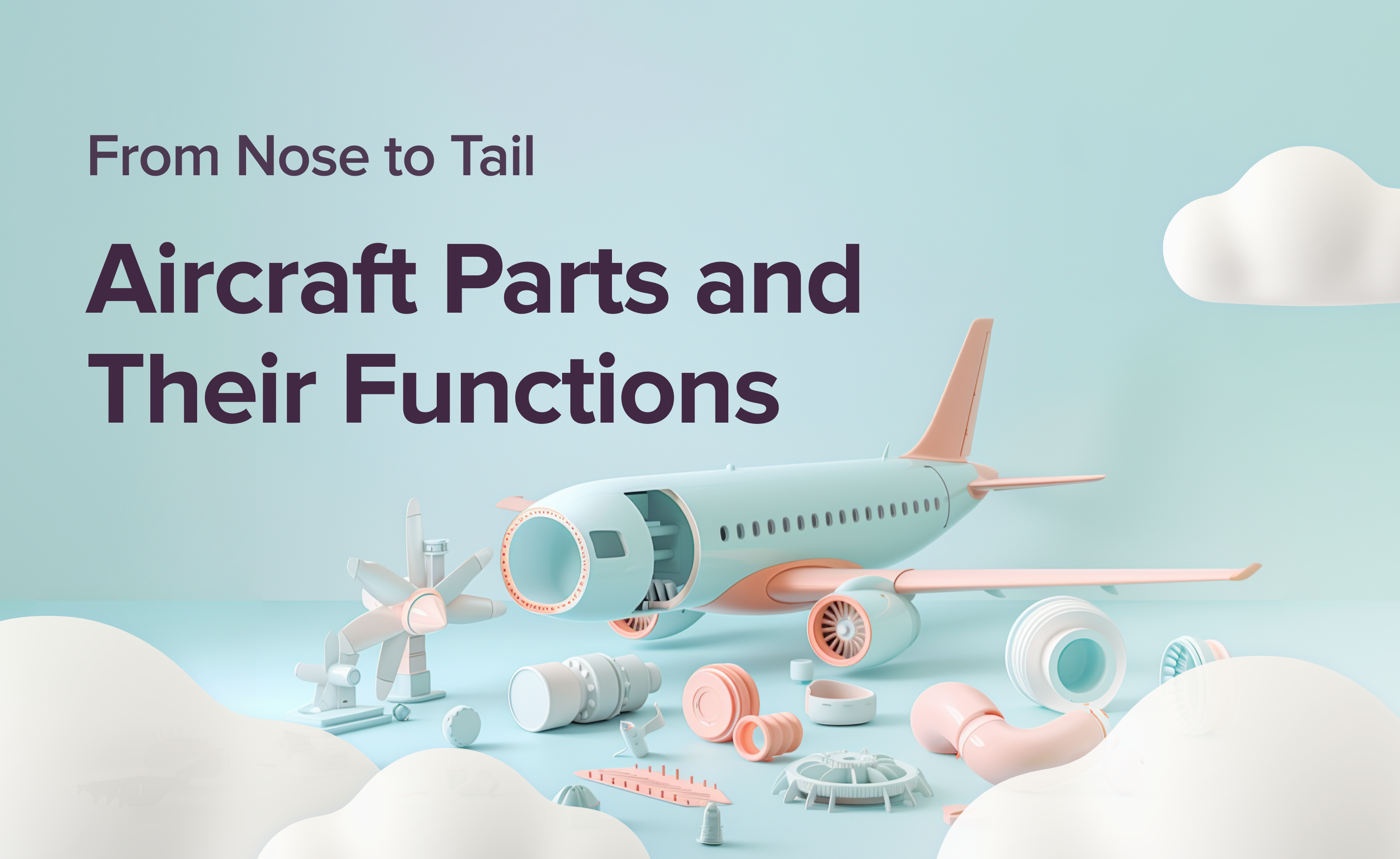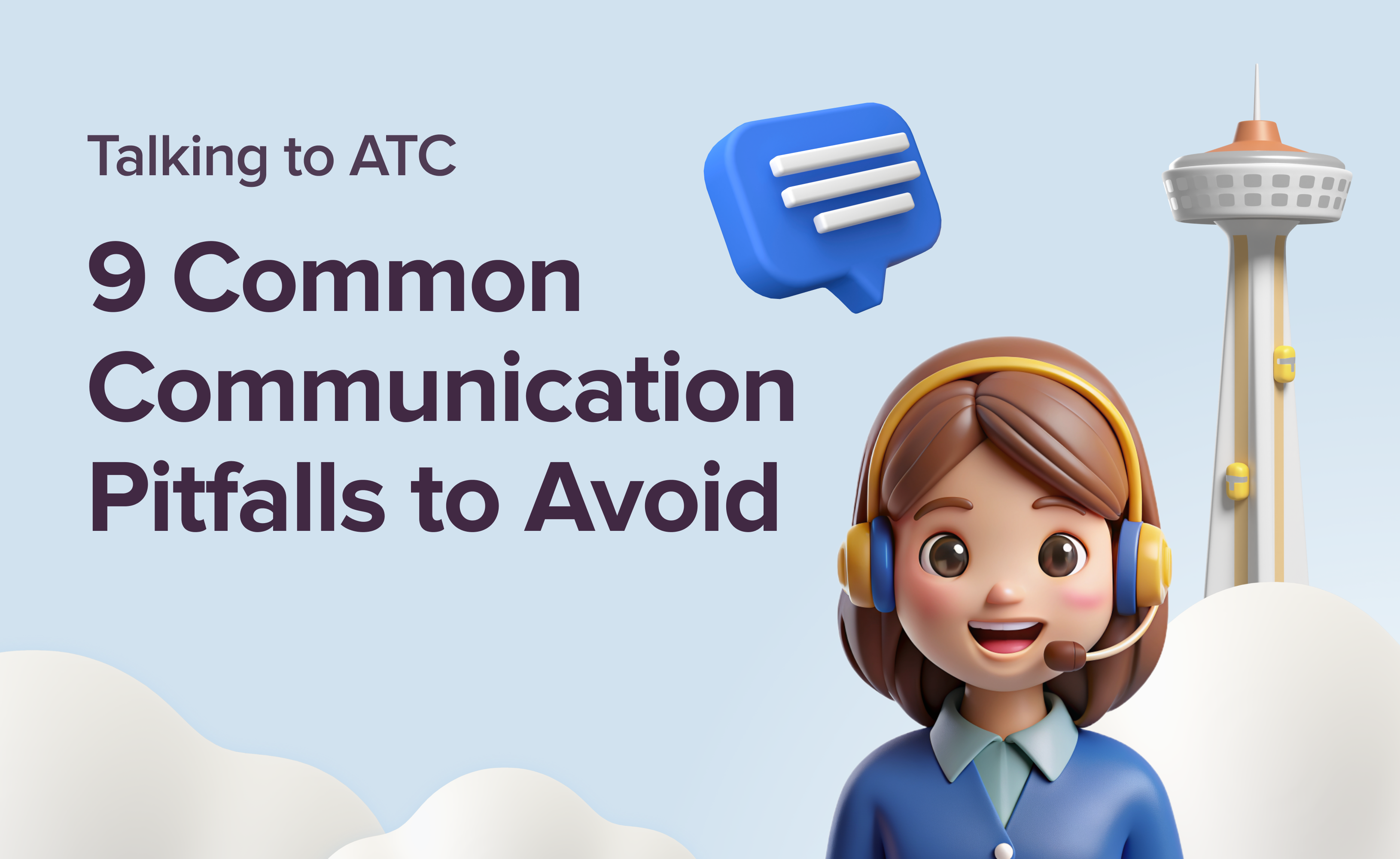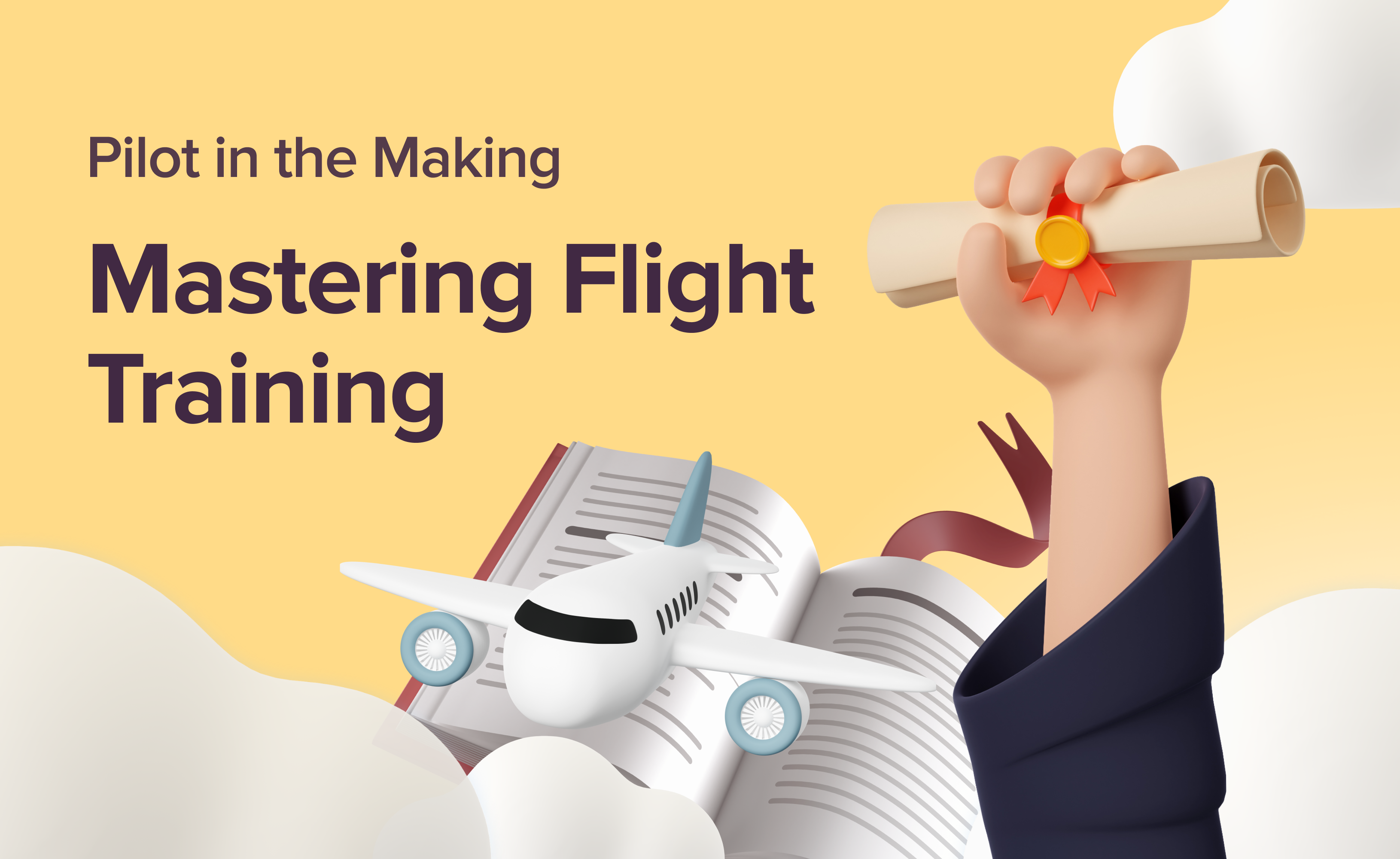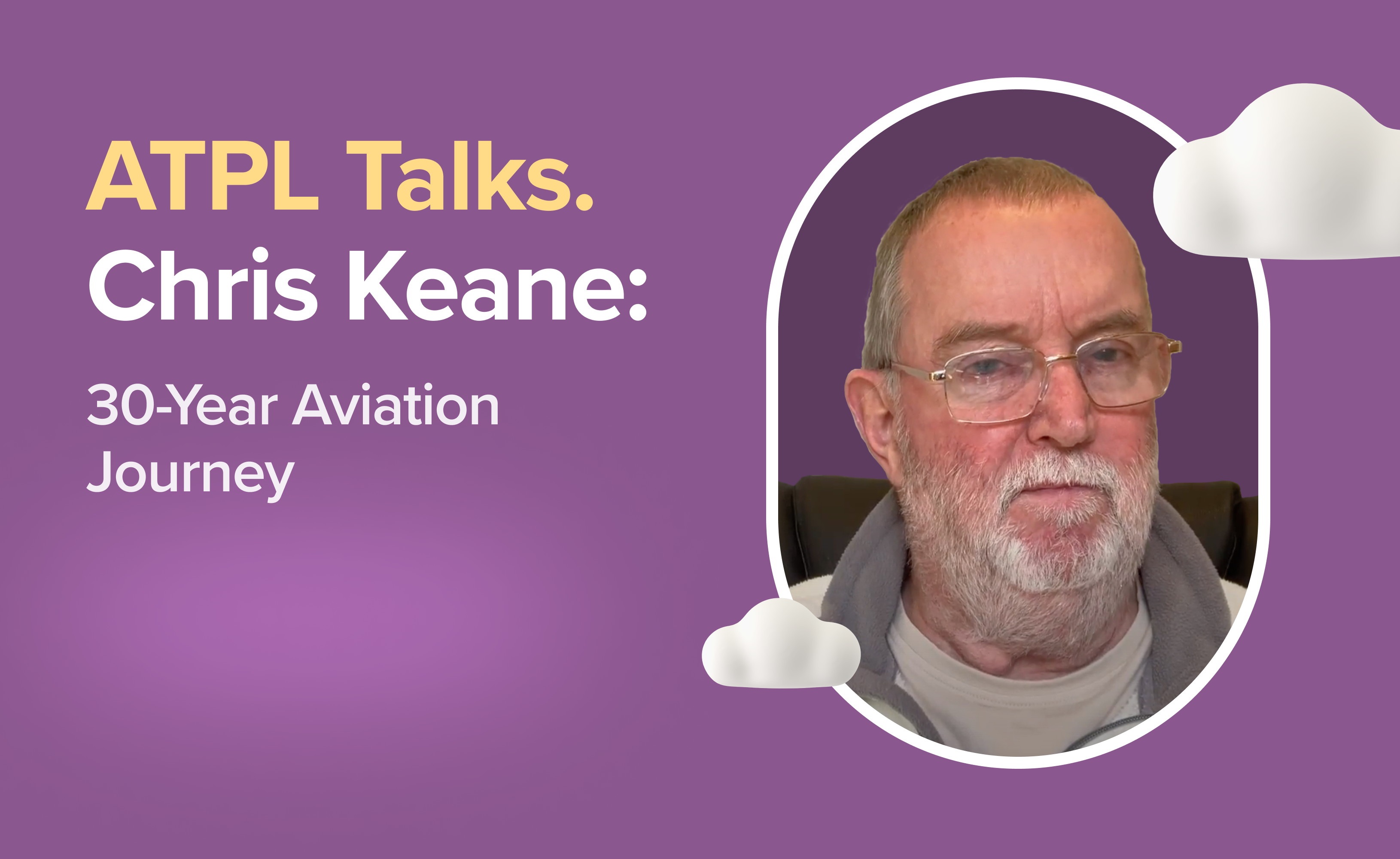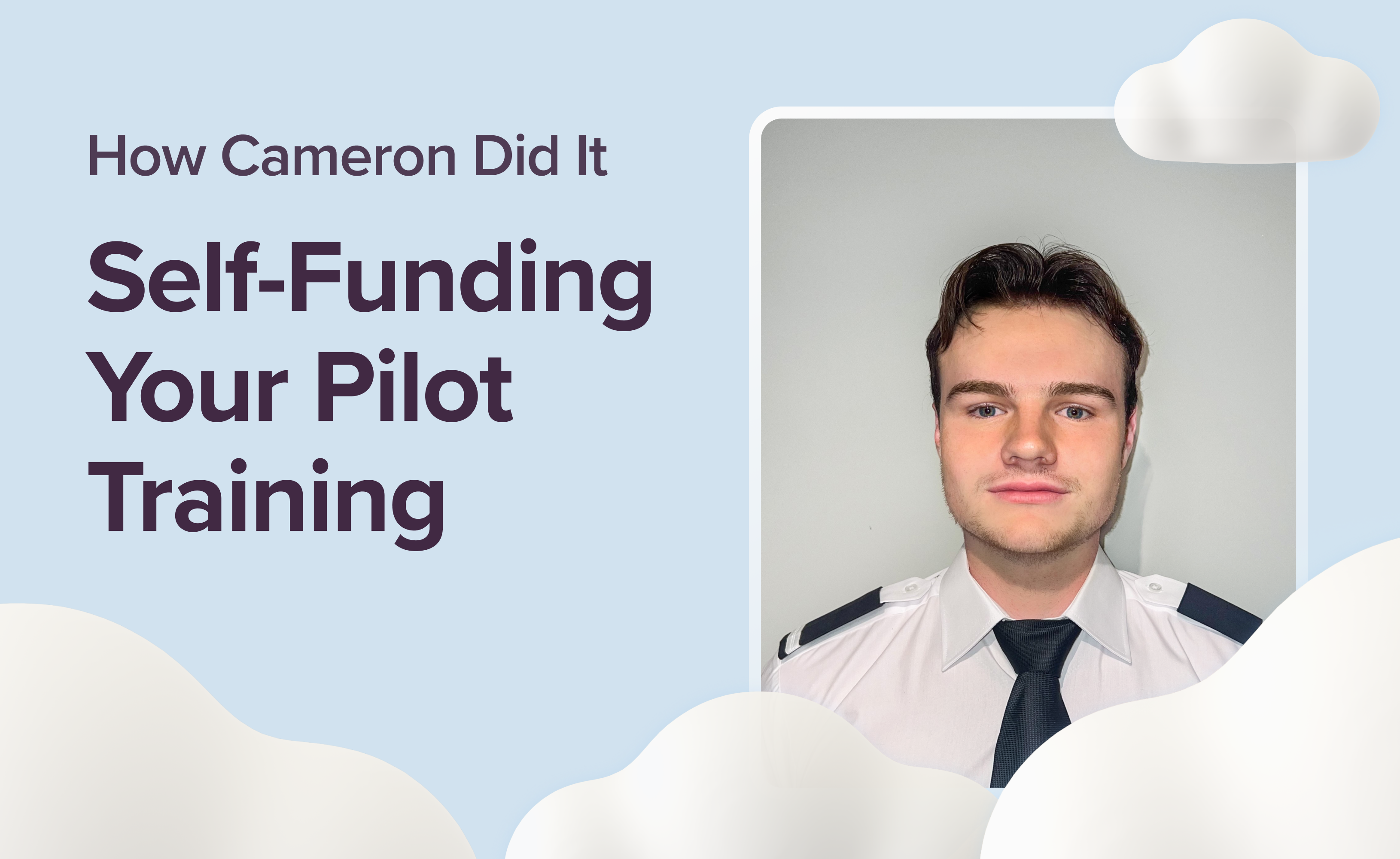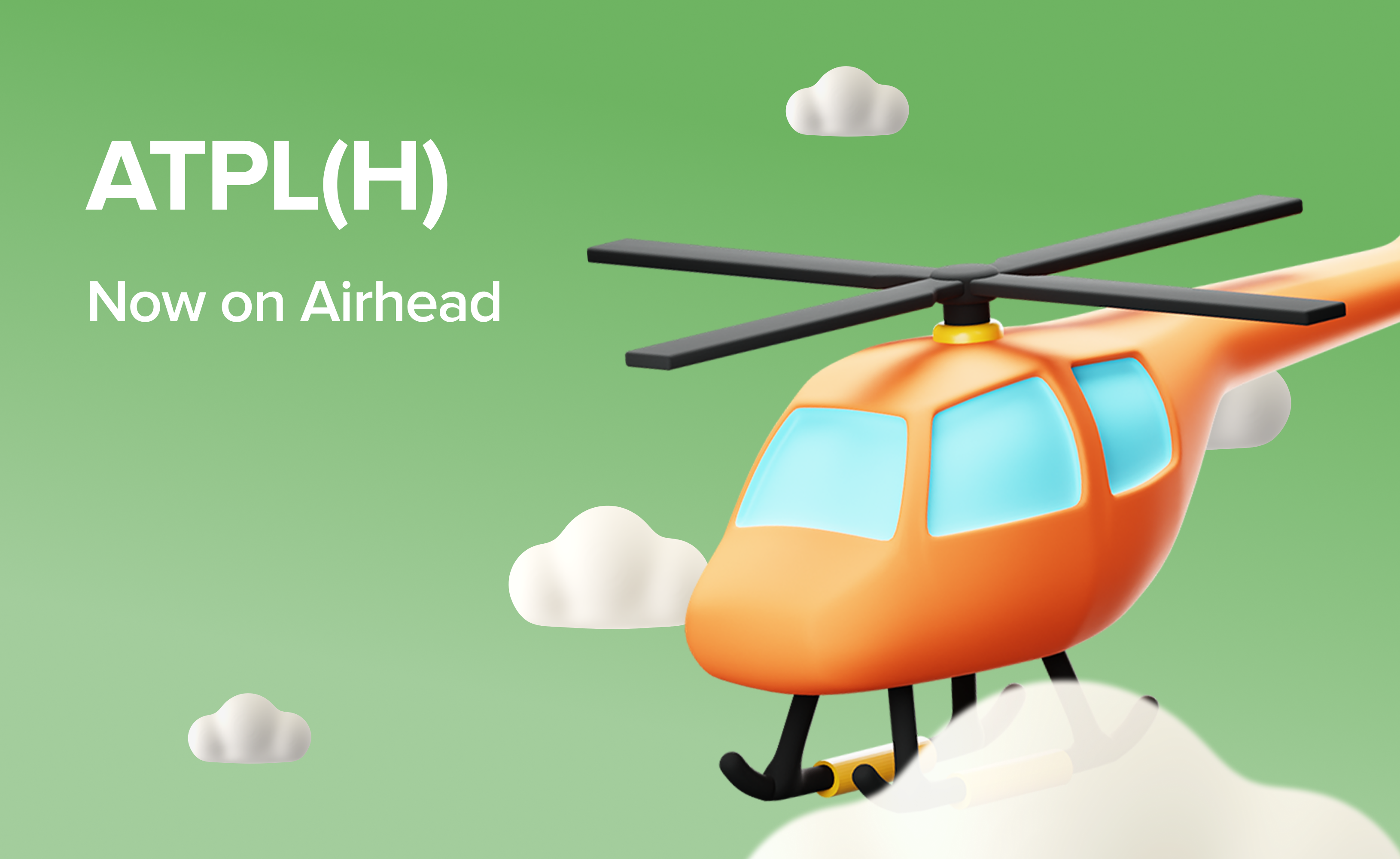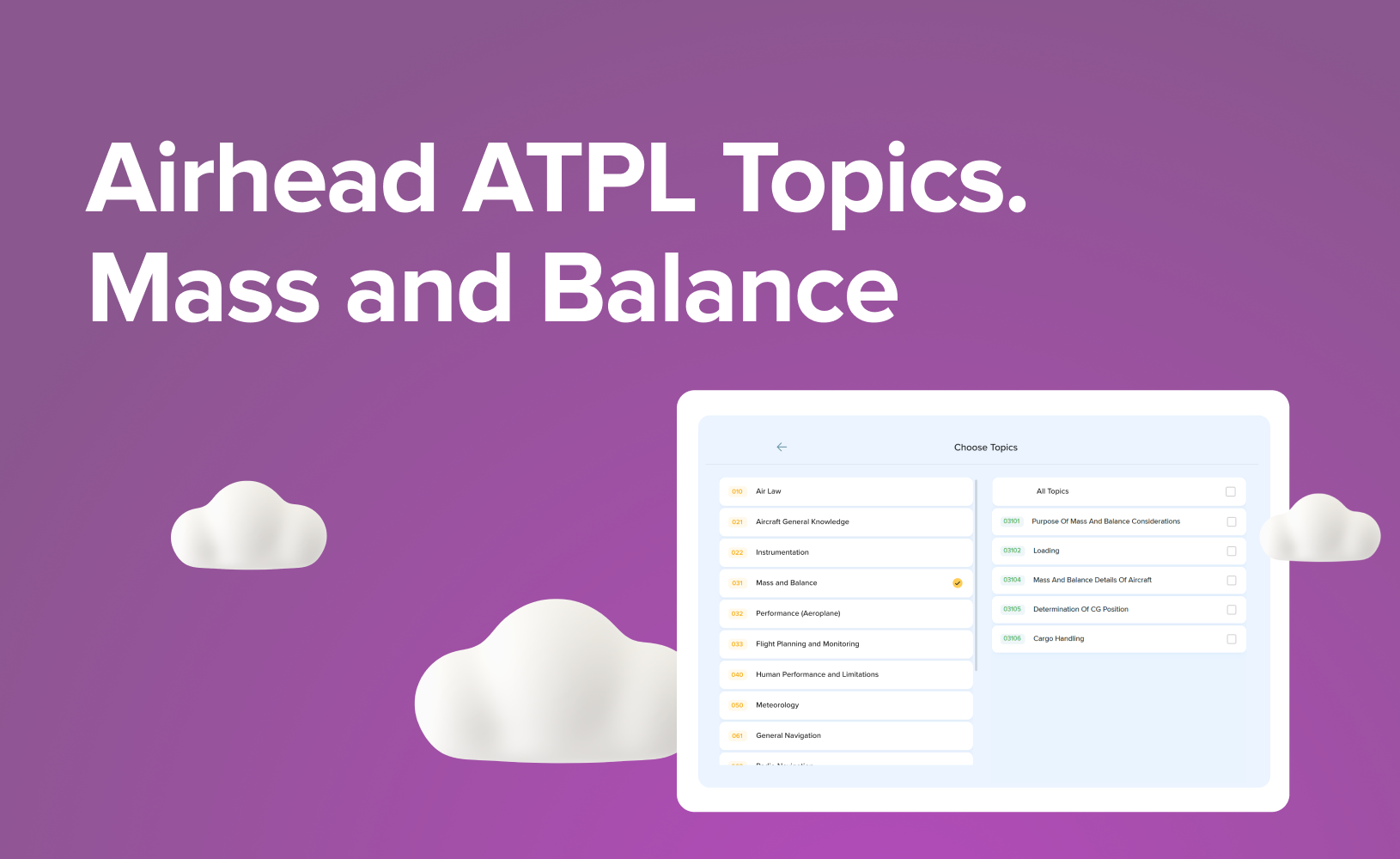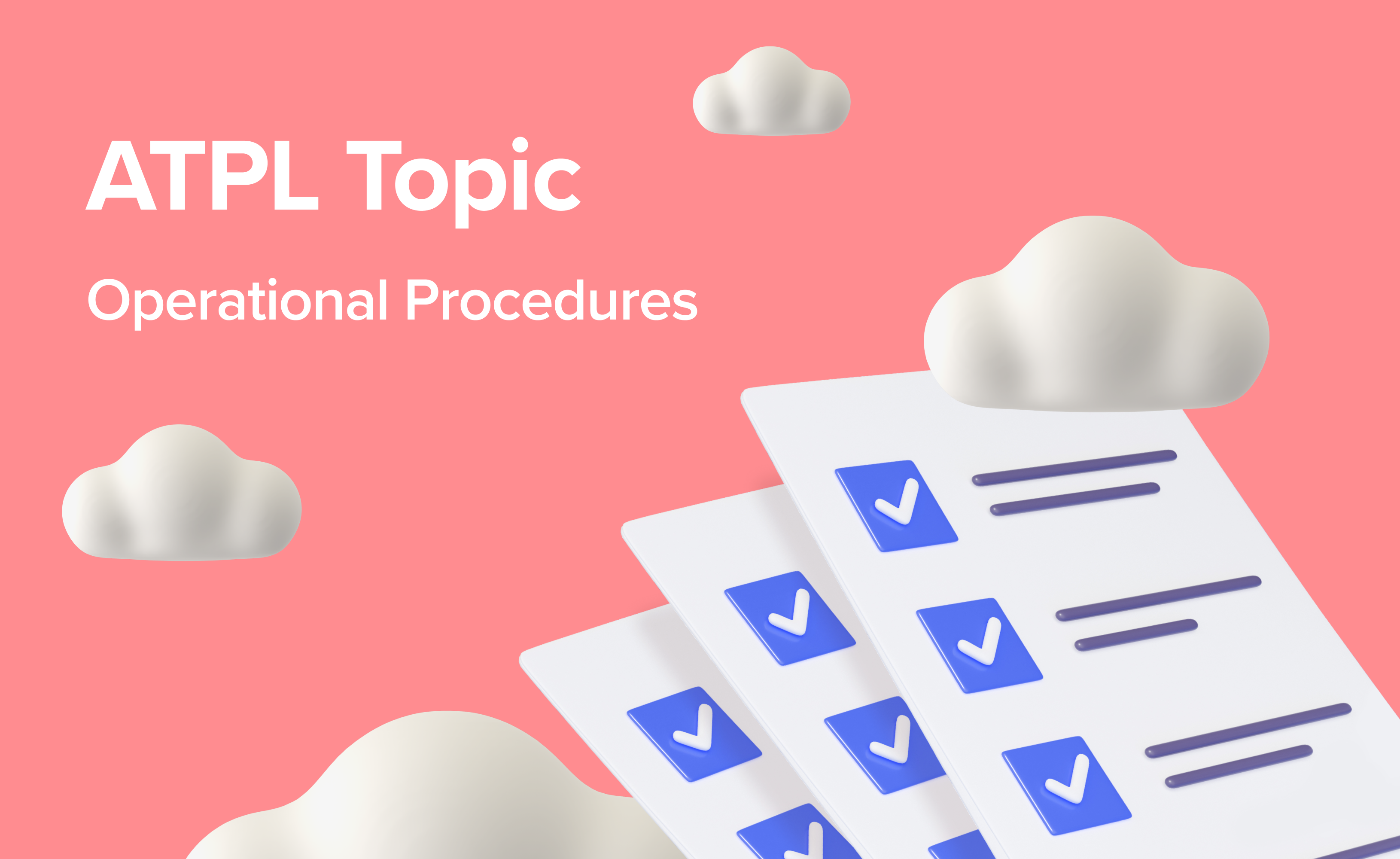Tried and True: 10 Ways to Become a Better Aviator
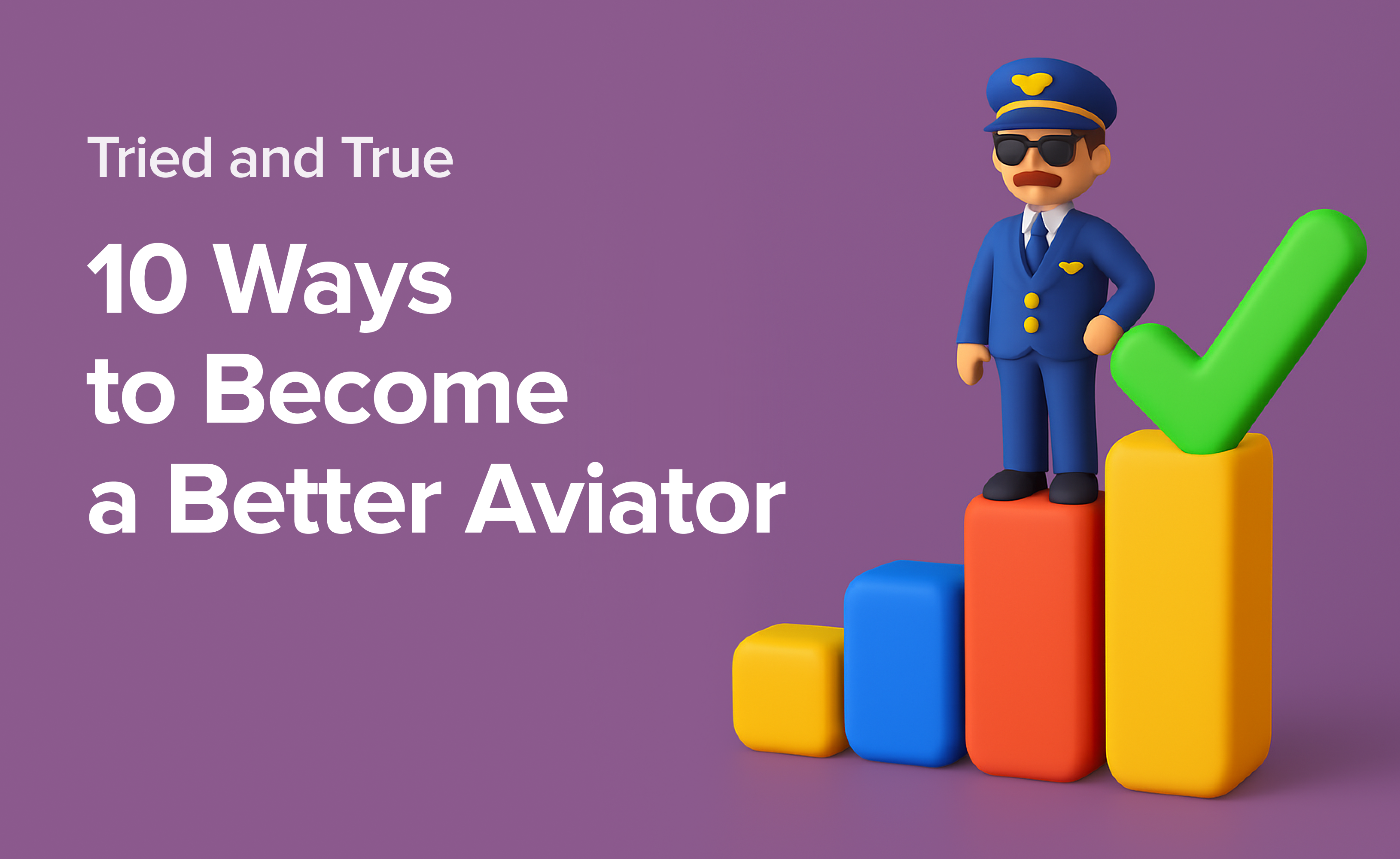
This list isn’t new — and that’s exactly why it matters. Years ago, AOPA Flight Training Magazine published a set of timeless tips on how to sharpen your flying skills. The advice was simple then, and it’s just as true today. Why? Because the fundamentals of good airmanship don’t change.
Generations of pilots have been taught the same lessons, and instructors still see the same habits, good and bad, show up in cockpits around the world. If you practise even a handful of these proven techniques, your flying will improve. It’s no more complicated than that.
1. Trust What You Feel in the Seat
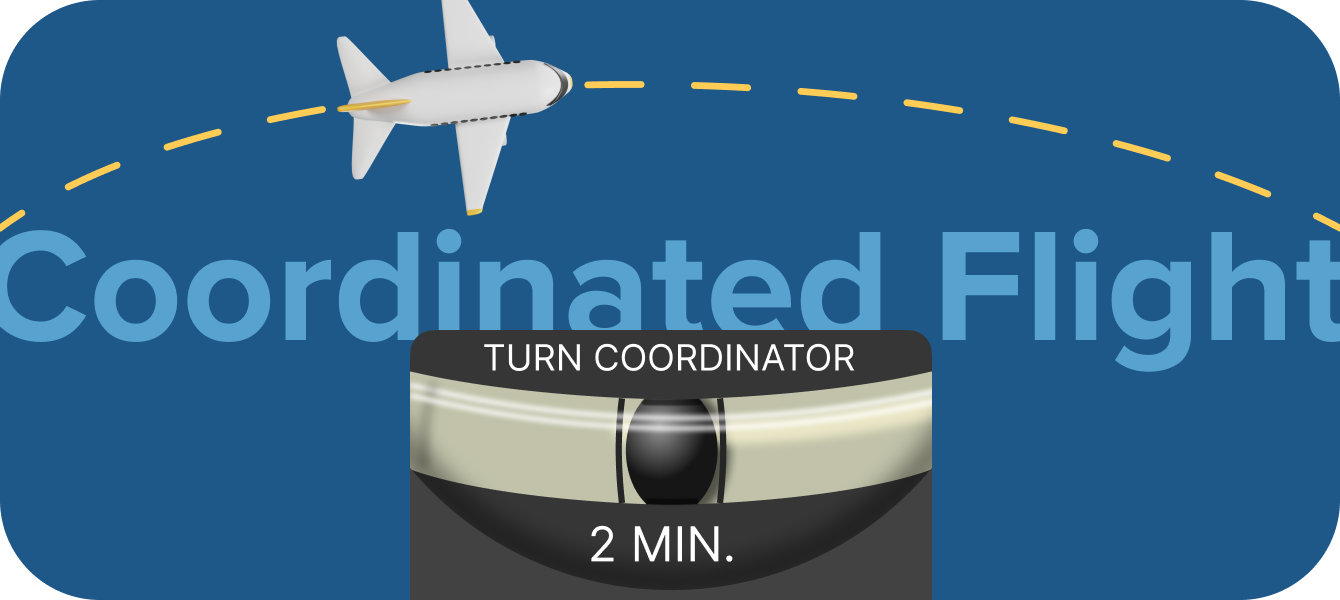
If there’s one skill that separates average pilots from truly sharp ones, it’s coordination. An aeroplane that’s in balance is smoother, more efficient, and easier to control. The secret is learning to “feel” what’s happening through the seat of your pants, not just chasing the skid ball with your eyes.
When you keep the ball centred, turns tighten up, climbs are cleaner, and your whole flying feels more precise. This is a skill you can deliberately train.
Practical hacks to sharpen coordination:
“Blind balance” drills – at altitude, perform some basic manoeuvres like turns and stalls; focus on sensing whether the aeroplane is sliding or skidding, then confirm with the turn coordinator.
Power change awareness – every time you add or reduce power, notice the yaw tendency. Train yourself to counter it with rudder instinctively.
Crosswind taxi practice – even on the ground, you can practice “flying coordinated” by keeping the nose straight with rudder, not brakes.
One-minute balance check – during every flight, dedicate 60 seconds to focusing solely on keeping the ball perfectly centred. Small investments build muscle memory.
A few minutes of practice like this in every flight pays huge dividends — you’ll start to trust your instincts, not just the instruments.
Simplify your flying maths. Discover 8 easy rules of thumb in our blog, Pilot Maths, for more intuitive and efficient flight.
2. Read the Nose for Speed and Attitude
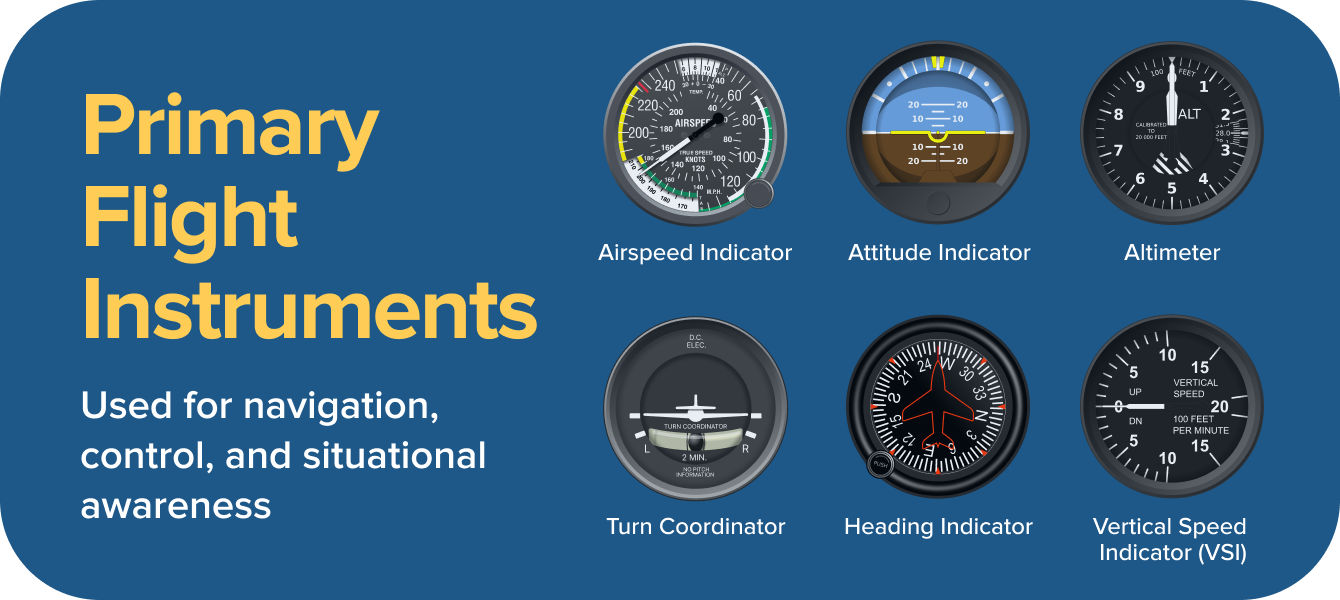
The nose tells you everything about your aeroplane’s energy state — long before the airspeed indicator does. That little “go-fast gauge” is just a delayed readout of what the nose has already shown you. Learn to read nose attitude, and you’ll always know whether you’re fast, slow, climbing, or sinking, without waiting for the instruments to catch up.
Practical hacks to train aeroplane nose awareness:
Sight picture catalogue – make a mental library of how the nose looks in different phases (climb, best glide, approach, flare). Compare them consciously until they become second nature.
Best-glide exercise – from cruise, trim for best glide using only the nose picture, then check the ASI for accuracy. Repeat in other configurations.
Pitch changes in turbulence – glance outside, not just at instruments, to see how the nose bobs. Use light corrections rather than chasing every bump on the ASI.
Pattern consistency – on downwind and final, focus on keeping the nose in the same sight picture each time. This consistency builds confidence in speed control.
Repeat this in different configurations, and soon you’ll recognise each “nose picture” instantly. You will fly more precisely, avoid dangerous slow-flight surprises, and have smoother landings because you are ahead of the aeroplane.
3. Build Aerodynamics and Situational Awareness
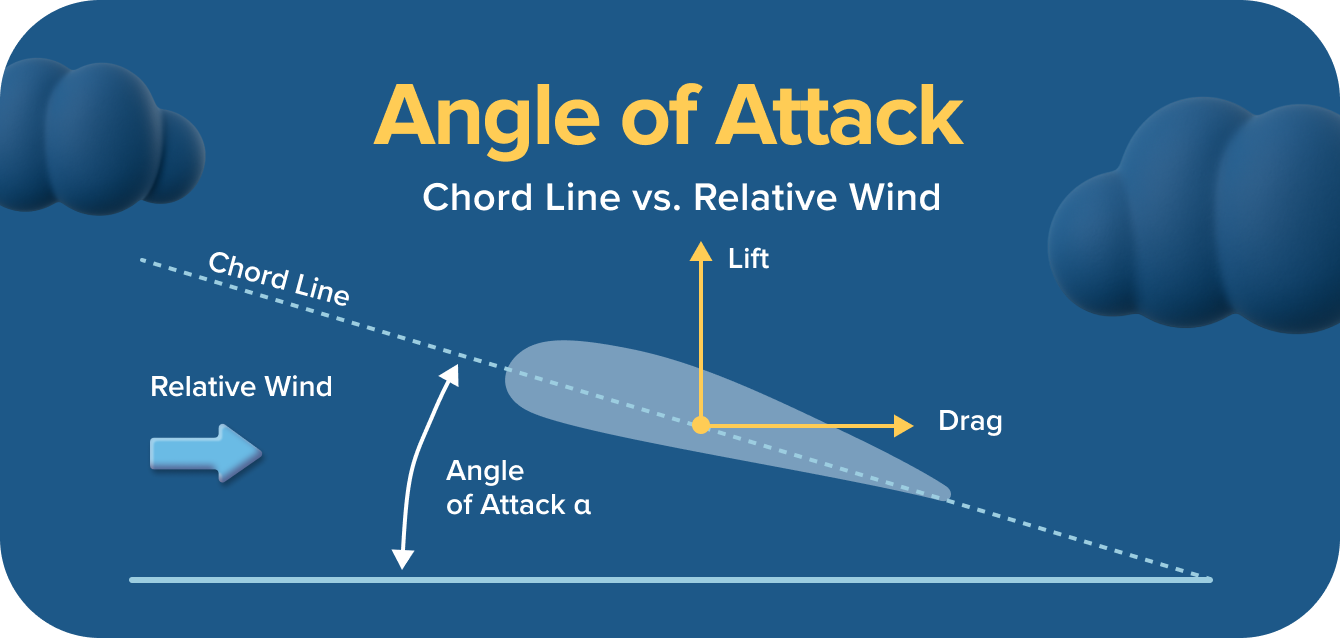
Understanding how the aeroplane really flies is one of the fastest ways to become a sharper pilot. Most aviators are familiar with the basics of lift and drag, but few take the time to delve deeper into angle of attack and how control surfaces influence the wing and tail. You don’t need to be an engineer — just a pilot with curiosity. With this knowledge, you start predicting how the aeroplane will respond before it does.
Practical hacks to sharpen awareness and aero understanding:
Angle of Attack exercises – at altitude, fly slow-flight and steep turns while asking yourself: “What’s my angle of attack right now? How close am I to the stall?” Tie the theory to the feel.
Configuration prediction – before lowering flaps or adding power, predict how the nose and speed will react. Then see if you were right. Over time, your instincts sharpen.
Four-point scan – every 60 seconds, cycle through “RPM, Altitude, Attitude, Pattern.” It’s quick, simple, and prevents tunnel vision.
Narrate your flight – try verbalising out loud (or quietly to yourself) what’s happening aerodynamically during manoeuvres. This habit locks in awareness.
See the big picture of aircraft climb. Our blog It's All Connected: TWR, Drag, and the Climb Rates breaks down the vital relationships you need to know. Dive in and understand how it all works.
4. Fly with Precision and Smoothness

In aviation, “close enough” isn’t enough. Precision means hitting target speeds, headings, and altitudes exactly. When you build the habit of flying with accuracy, it becomes second nature in critical moments, from approaches to emergencies.
Smoothness goes hand-in-hand with precision. Abrupt, heavy-handed corrections usually lead to overshoots and more corrections. But small, steady inputs keep the aeroplane where you want it with less effort. Think of guiding the aeroplane with finesse rather than forcing it.
Practical hacks for precision and smooth flying:
Pattern accuracy – on each downwind, base, and final, aim to nail the exact speeds and flap settings at the right spot — every time.
Exact airspeeds – if the POH says the best glide is 65 knots, practice holding 65 — not 63 or 68. Train your brain to lock onto numbers.
Cross-country drills – on long legs, challenge yourself to keep heading within 2° and altitude within 50 ft. Small margins build big discipline.
The “gentle nudge” rule – never make one big correction. Break every adjustment into a series of tiny, smooth nudges. It reduces overshoot and makes the aeroplane feel almost effortless.
Hands-off test – after trimming, let go briefly. A well-trimmed and smoothly flown aeroplane should stay stable without constant wrestling.
When you strive for precision and fly smoothly, the aeroplane starts to “cooperate” with you. Flights become less tiring, landings more consistent, and your overall control sharper.
Our latest blog, In the Loop: How to Fly the Basic Traffic Pattern, breaks down each leg of the traffic circuit, explaining what to expect at every stage and how to fly it with ease and safety.
5. Make Your Landings More Accurate
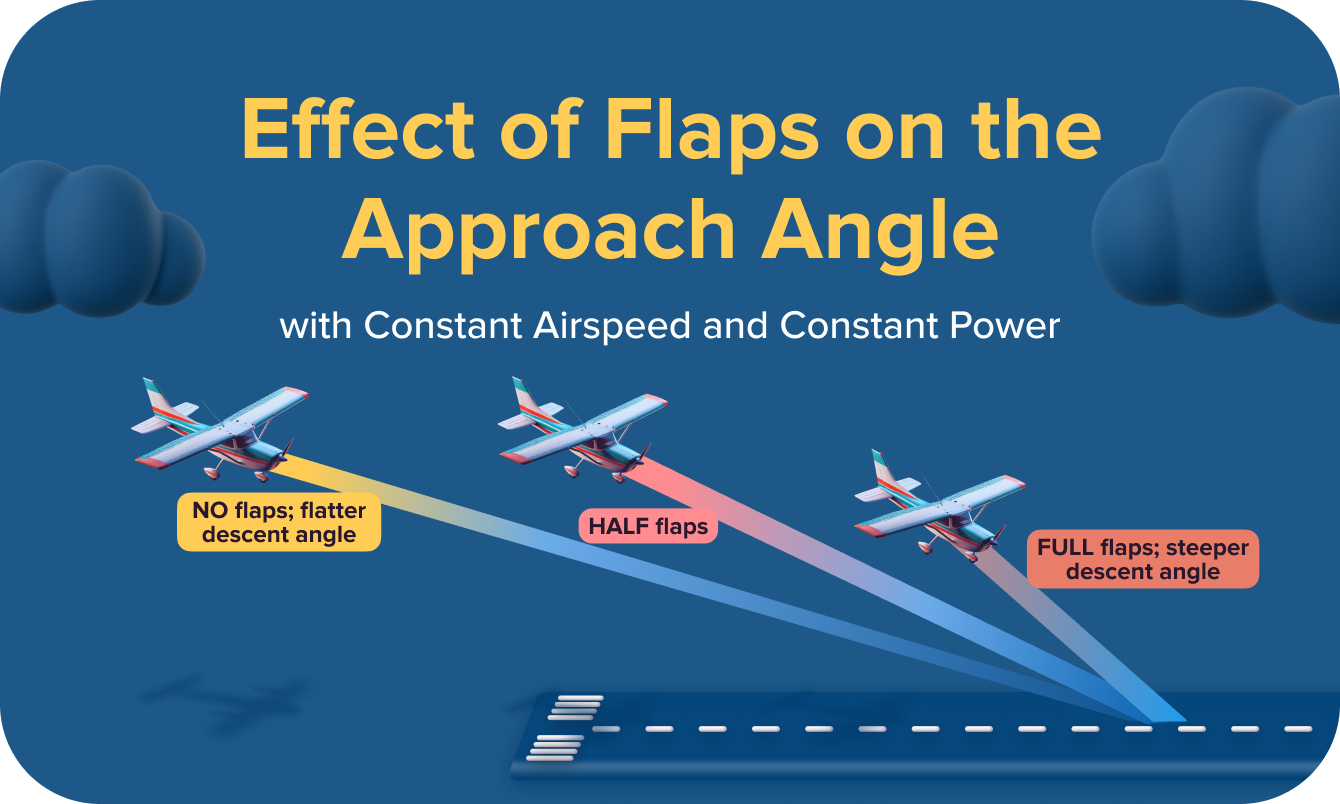
Almost every flying skill comes together in the traffic pattern, which is why landings are the ultimate test of a pilot’s precision and awareness. Use the runway numbers as your aiming point and challenge yourself to consistently touch down within the first 600–800 feet. The more repeatable your landings, the more confidence you’ll carry into every phase of flight.
But landings aren’t just about hitting the numbers—they’re about staying sharp. Practising touch-and-goes and planned go-arounds keeps you comfortable with the workload and prepares you for real-life surprises.
Practical hacks for sharper landings:
Pick an aiming point – keep the runway numbers fixed in the windscreen. If they rise, you’re short; if they sink, you’re long.
Every third landing = touch-and-go – double your practice in the same flight. It adds proficiency without adding flight hours.
Scheduled go-arounds – don’t wait for a mistake. Plan to go around now and then. Build muscle memory for a moment that could save your life.
Crosswind reps – practice in challenging winds, not just calm conditions. It’s the only way to build true landing confidence.
Short-field mindset – even on long runways, fly as if you only have 2,000 feet. This habit sharpens your precision and discipline.
Consistently achieve smooth landings and master flap adjustments with our in-depth guide, Flaps, Lift & Drag: The Secret to Smooth Landings.
6. Think Ahead of the Aeroplane
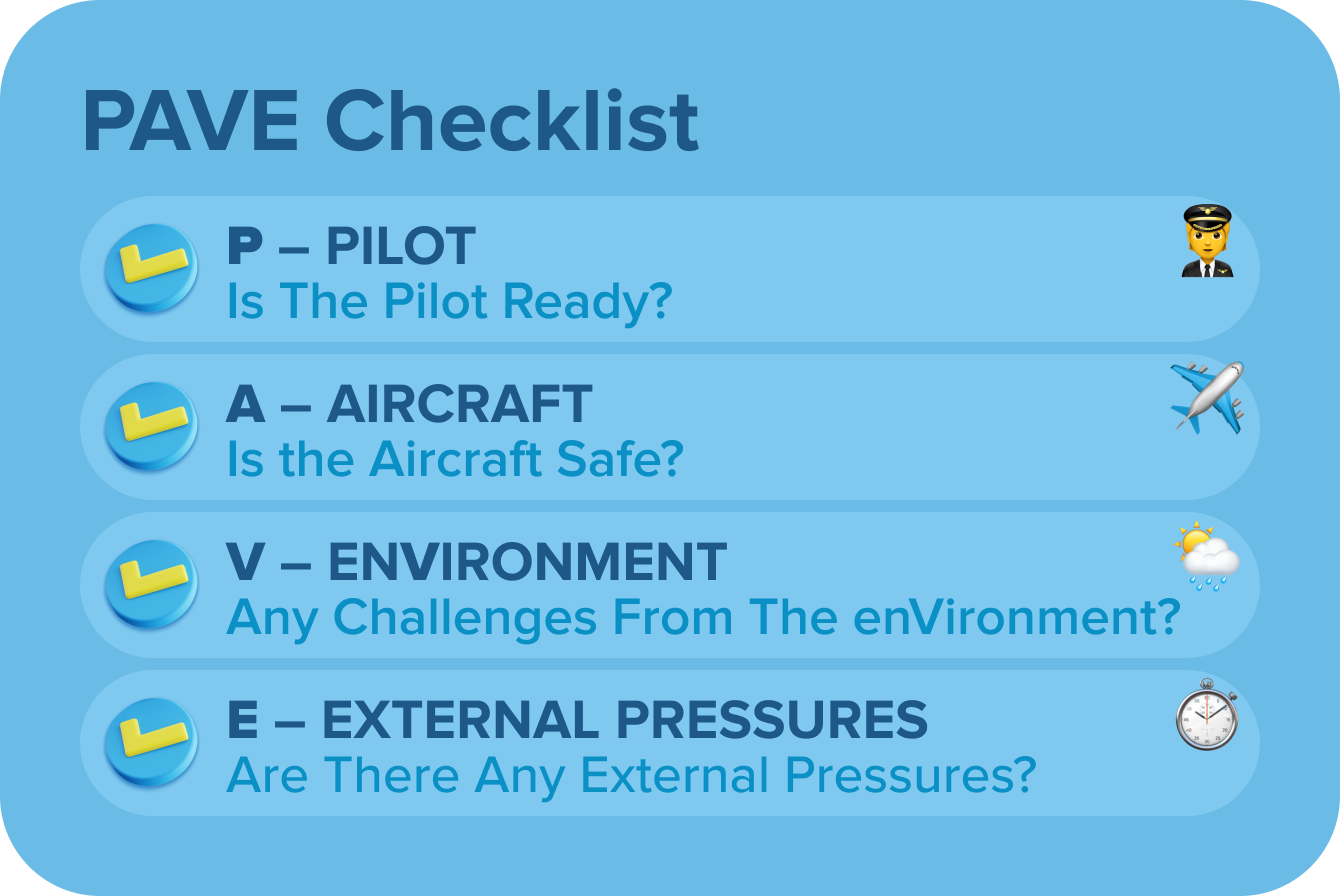
One of the greatest differences between new and seasoned pilots is mental pacing. The best aviators stay one or two steps ahead of the aeroplane. Whether it’s planning where to turn base, when to add flaps, or where the next fuel stop will be, anticipation makes flying smoother and safer.
Thinking ahead isn’t just about planning the “big picture” like cross-country fuel stops — it’s also about the micro-decisions in the pattern or during a climb. You should always be asking: “What comes next?”
Practical hacks for staying ahead:
One-minute mental preview – before each phase (take-off, pattern, approach), quickly run through what you expect to do next.
Downwind decisions – on downwind, you already know where the base will be and when flaps come in. That way, you’re not scrambling.
Wind check – glance at the windsock or ATIS (Automatic Terminal Information Service) early, and adjust your mental picture of how the approach will change.
Use the PAVE checklist – Pilot, Aircraft, enVironment, External pressures. This structured preflight scan helps you spot risks before they become distractions.
Run the I’M SAFE checklist – Illness, Medication, Stress, Alcohol, Fatigue, Emotion. A quick self-check ensures you are truly ready to fly.
De-clutter time – if you arrive at the airport distracted, sit in the car for two minutes to clear your mind. Don’t strap in until your focus is 100% on flying.
A pilot who thinks ahead flies smoothly, manages workload better, and is always ready when things don’t go as planned. Test your decision-making skills with 8 challenging scenarios faced by pilots. Read more in our blog Decision-Making: 8 Key Scenarios for Pilots and see how you'd react.
7. Turn Every Flight into Training
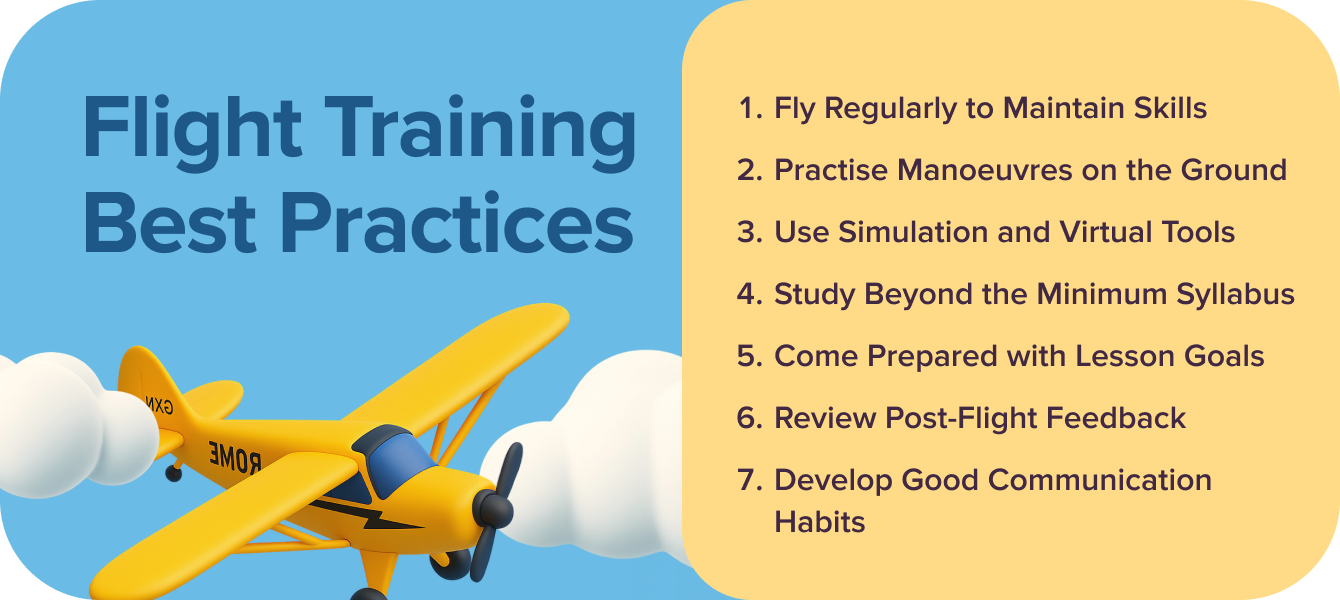
Every single flight is a chance to get better. Whether it’s a short hop for lunch or a cross-country, you can turn routine flying into practice time. Repetition is what builds confidence, so mix in new techniques, new airports, and challenges that stretch your skills.
Instead of only flying from your home base, challenge yourself with shorter runways, unfamiliar fields, or tighter patterns. Every time you step out of your comfort zone, your proficiency expands.
Practical hacks to turn routine into training:
Mini-manoeuvres – on any flight, throw in one practice: a short-field landing, a simulated engine-out, or a soft-field take-off.
New airports rule – make it a personal challenge to land at every airport in your county or region. Familiarity with variety = adaptability.
Short-field practice – with an instructor, go land on shorter runways than you’re used to. It builds accuracy and calm under pressure.
Tighter patterns – challenge yourself to fly smaller circuits. It sharpens judgment and energy management.
Debrief habit – after every flight, ask: “What did I practice today? What can I polish next time?”
Flying is all about building skill. The more you train in small ways, the more capable and confident you’ll be in big moments.
Don't let common pitfalls derail your pilot journey. Discover 9 Flight Training Mistakes to Avoid and stay on track to earning your wings.
8. Practise Crosswinds Early and Often

Face the crosswind demon early. It’s one of the most rewarding skills you’ll ever own. Many pilots avoid crosswind landings, but real confidence comes only when you practice them. A good crosswind technique will serve you for life. Don’t wait until you’re caught in a howling gust — go out deliberately and face it with an instructor. Work up from moderate conditions to winds at the edge of your aeroplane’s crosswind envelope. Once you’re comfortable, keep practising on your own in less severe conditions to keep the skill fresh.
Practical hacks for crosswind confidence:
Schedule crosswind flights – don’t cancel every breezy day. Ask your instructor to go up when the winds are challenging.
Use smaller airports – at non-towered fields, you often have access to more crosswind runways. Practise when traffic is light.
Master the slip – practice forward slips and wing-low approaches until they feel second nature.
Work both sides – train in left and right crosswinds. Pilots tend to favour one side, but both matter.
Repeat frequently – once you “get it,” keep doing it. Even several crosswind landings a month will keep your technique sharp.
Master the art of crosswind landings with our comprehensive guide. Read more and become a confident pilot, Taming the Wind: Crosswind Landings Explained.
9. Take Three Hours of Upset Training
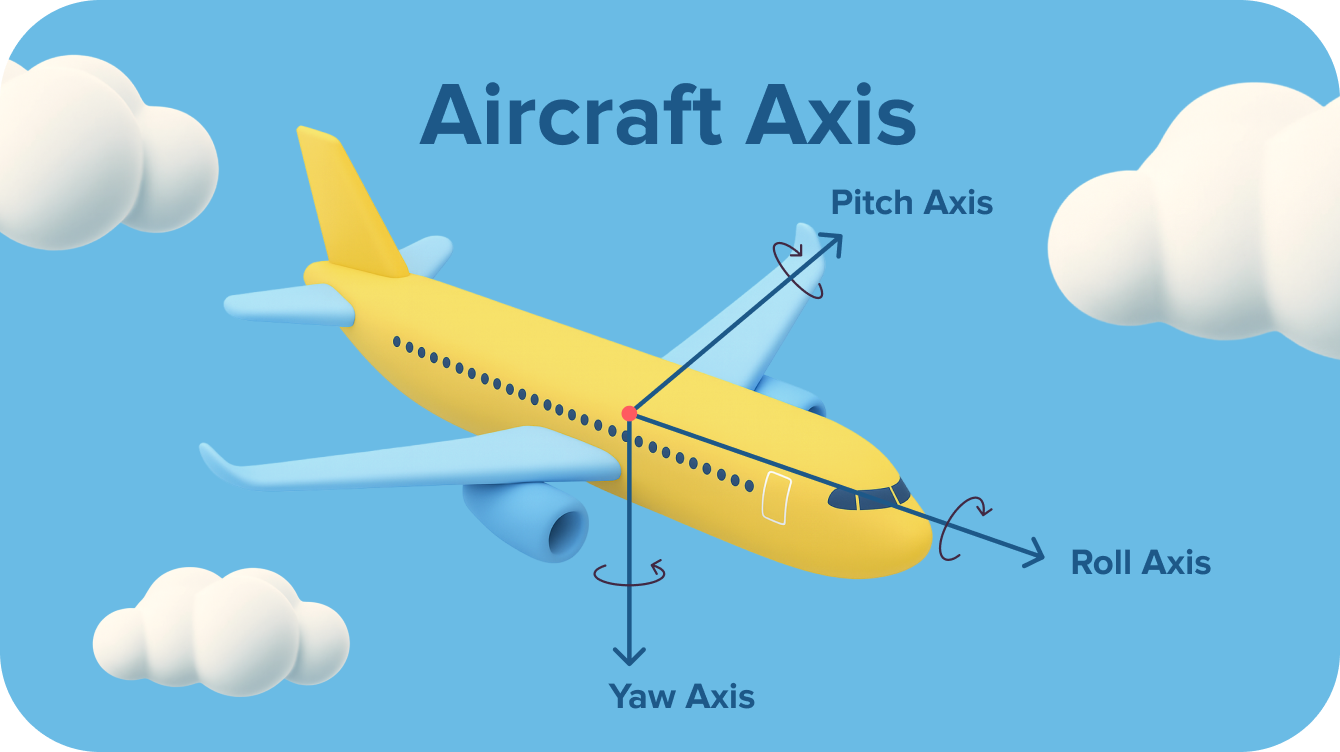
A few hours of aerobatic or upset recovery training change your flying. It teaches you what the aeroplane feels like when pushed to its limits and gives you the confidence to recover early from unusual attitudes before they become dangerous.
This training is about safety. You’ll learn how to recognise and correct spins, spirals, and wake turbulence encounters. You’ll also discover just how much more both you and your aeroplane can handle than you might think.
Practical hacks for upset training:
Book at least three hours – enough time to cover spins, recoveries, and basic manoeuvres.
Set the right goal – tell your instructor you want safety-focused training, not competition aerobatics.
Focus on real-world threats – spins, steep spirals, wake turbulence, and disorientation recovery.
Take notes immediately after – the sensations fade quickly; record what you learned.
Revisit every few years – like crosswinds, this skill fades if you don’t touch it again.
Are you aware of the attitudes that can sabotage your flying? Discover 5 risky mindsets every pilot should check.
10. Stay Curious and Keep Learning

As a student pilot, you’ve already discovered the vast amount of knowledge required just to take off on your aviation journey. From mastering air law to understanding meteorology and flight navigation, it quickly becomes clear that flying demands much more than stick-and-rudder skills. What you’re building now is a solid foundation, but that foundation must be continually strengthened and expanded. That’s where the principle of continuous learning comes in.
A great pilot never stops being a student. The best aviators understand they don’t know everything, and they embrace curiosity as a tool. When a weather pattern, a navigation rule, or a new piece of technology doesn’t make sense, they seek answers. That curiosity keeps their knowledge sharp and their flying safe.
Challenge yourself with modern training tools, webinars, or conversations with seasoned pilots. Every unanswered question is a potential risk waiting to surface. Don’t let them pile up, keep learning, keep asking, and keep refining.
Practical hacks for lifelong learning:
Identify your blind spots – if something feels fuzzy (weather charts, avionics quirks, regs), make it a study topic.
Ask questions often – flight instructors, the aviation community like Airhead, and organisations like AOPA are great resources.
Read one aviation-related book a year – texts like Stick and Rudder or Fate Is the Hunter sharpen fundamentals.
Fly somewhere new each month – every new airport teaches you something about adaptability. Join the community – attend safety seminars, listen to pilot podcasts, or swap lessons learned at the hangar.
Continuous learning is key for every pilot. Discover the importance of a lifelong commitment to learning in our blog, Fuelling Curiosity: Lifelong Learning as a Pilot.
Small Inputs, Big Results
Flying is built through small, deliberate efforts repeated day after day. A little more precision here, a little more curiosity there, a little more practice — stacked over time, they transform you into the kind of aviator who flies with confidence, awareness, and grace. So keep showing up, keep refining, and trust that every small step you take today is quietly building the pilot you dream of becoming tomorrow.
Because in aviation, as in life, the little things aren’t little—they’re everything.
